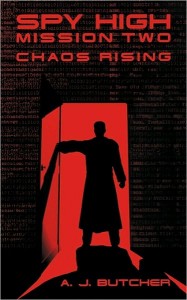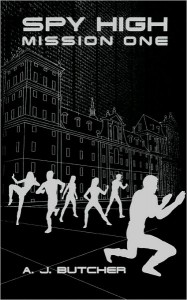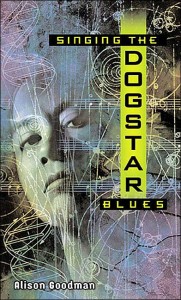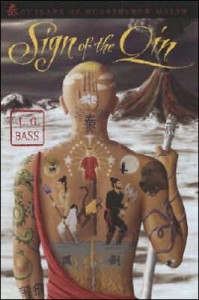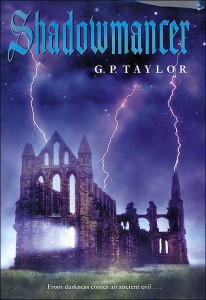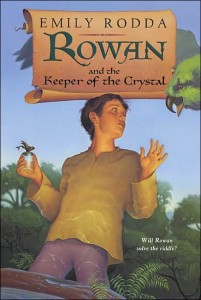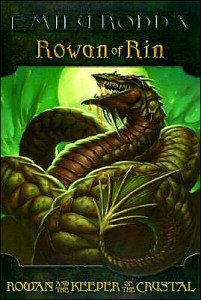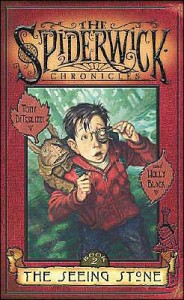

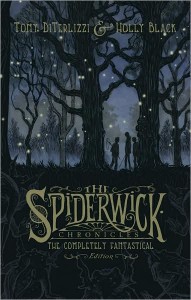
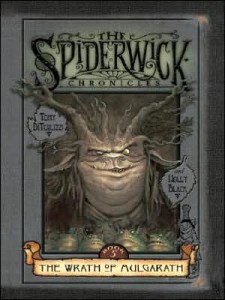
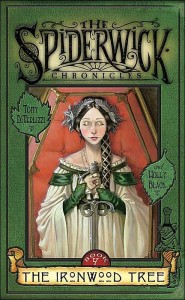
 Book 1:The Field Guide
Book 1:The Field Guide
When Jared, Mallory, and Simon Grace move into their Great-Aunt Lucinda’s house, the Spiderwick Estate, they have no idea what to make of the place. It’s huge, rambling, and some parts are in disrepair. But it’s out of the city, and a good place for the family to start over. What more can their single, overworked mother ask for? However, when odd things begin to happen, the children discover more than they bargained for. Not only is there a secret room where their ancestor Arthur Spiderwick used to work, there’s a bizarre field guide for fairies and other mythical creatures, secreted away in a trunk. And then the children find the boggart, the source of their domestic woes. If they can appease him, he’ll stop trashing their belongings and getting them in trouble. They hope. The Field Guide is just the beginning of what promises to be interesting times ahead for the three children.
Book 2: The Seeing Stone
In the second book, The Seeing Stone, the Grace kids are still learning about the dangers of the field guide, as their refusal to destroy it brings more unwanted supernatural attention on their heads. This time, they’ll meet the trolls and goblins of the area, and undoubtedly regret the encounter in the end. But will they make it home in time for dinner?
This five book series is written on the same level as the Series of Unfortunate Incidents, though less vicious in spirit, and should appeal to the same audience, as well as anyone with a childlike love of fairies and goblins and things that go bump in the night. Co-author Holly Black, whose first book, Tithe, was an intriguing look at the world of Faery through teen eyes, brings the story down to a juvenile level without losing any of the excitement. The true strength, however, lies in the packaging. Handsomely bound with copious illustrations by co-author Tony DiTerlizzi in both black and white and color, they’re as much artistic as they are literary. By releasing them as five smaller books as opposed to one larger story, the authors are free to heighten the excitement of each individual episode and add the illustrations, themselves a vital part of the enjoyment factor. Though recommended for ages 6-10, I’m sure older readers might be just as amused.
Book 3: Lucinda’s Secret
The Grace children, Mallory, Simon, and Jared, are back, in the third installment of their brush with the creatures of Faerie. Things have been unusual around the house, ever since they discovered Arthur Spiderwick’s Field Guide, which opened their eyes to the existence of goblins, elves, trolls, boggarts, griffins and more. In fact, things have been downright dangerous! The magical beings of Faerie want that book, and they’re willing to play dirty in order to remove the proof of their existence from view. The Grace children, however, aren’t pushovers. They’ve already outwitted a bunch of goblins and rescued a griffin from dire peril (it’s in the barn, now). How bad could the next batch of magical menaces be?
Deciding to seek out their answers at the source, the three go to visit their Great-Aunt Lucinda, who’s currently enjoying an extended stay at a mental hospital. The story she has to tell them, about Faerie and its dark temptations, is enough to make them reconsider keeping the Field Guide. One problem. Someone’s stolen the Guide, and if the Grace children can’t get it back, how will they know what sort of dangers lurk in the woods? Their quest to recover the guide will bring them face to face with the playfully prophetic phooka, and into the clutches of the beautiful, yet deadly, elves. One of the three children may never go home again, if they can’t out think their captors….
Once again, Holly Black and Tony DiTerlizzi produce an inventive, fascinating look at the intersection of the mortal world and Faerie. The pace is quick, yet not hasty, and the plot moves right along with plenty of twists and turns. We’re more than halfway through the five book series now, and while things are heating up, I’m fully confident we’ll see a satisfactory resolution and answers to all our questions by the end. The Spiderwick Chronicles are like a more upbeat Series of Unfortunate Events, with some good old-fashioned, old-school dangerous fairy tale influences. One strong selling point continues to be the design of the books: DiTerlizzi’s artwork captures both the whimsy and the distinct unreality of the Fae, while rooting them in the modern realness of the protagonists. Add to that the handsome hardcover format, and these are books that’ll look good on the shelf as a set.
Book 4: The Ironwood Tree
Things really heat up for the Grace children, Simon, Mallory, and Jared, in The Ironwood Tree, fourth in a five book series chronicling what happens when three ordinary kids discover the truth about the magical world around them. Someone’s stolen Arthur Spiderwick’s field guide, a book which details the creatures of Faerie in all their capricious, treacherous glory, but other factions who haven’t gotten the memo are still trying to get it away from the Graces. When a shapeshifter starts impersonating the children and getting them in trouble, things are bad. When someone kidnaps Mallory and demands the field guide in exchange, things get even worse. How can Jared and Simon rescue their sister from the local dwarves when they don’t have the book to bargain with? What’ll happen when they’re betrayed in turn, and who’s behind all of these supernatural problems anyway? Plenty of questions, and very few answers, are to be found as the story rushes headlong towards the final showdown between mortal and faerie.
The most frustrating thing about the Spiderwick Chronicles has to be the wait between books. They’re relatively quick reads, over far too soon for my tastes, especially since the world presented is interesting enough that I’d like to stay a while longer. I think the characters and setting could easily warrant a full-length novel, though I’d still want plenty of Tony DiTerlizzi’s fantastically whimsical drawings to go with the words. This is a great series, and I wouldn’t mind seeing more even after the fifth book and the Field Guide itself are published. One thing to watch out for: though most of the story is appropriate for ages 7 and up, there’s a scene near the end that’s a bit bloodier and more violent than the rest, yet wholly in keeping with the nature of the Faerie creatures involved. That aside, what are you waiting for?
Book 5: The Wrath of Mulgarth
Their house has been ransacked, their belongings trashed, and their mother kidnaped. Now the Grace children, Jared, Simon, and Mallory, must find a way to outwit Mulgarth the ogre. On his side: an army of goblins and dragons. On their side: a griffin, a brownie, a hobgoblin, and the outdated advice of their great-uncle Arthur, whose Field Guide to the creatures of Faerie initially got them into this mess. How on Earth can a handful of kids and minor Fae face off against a shape-changing ogre king and his poisonous, fire-breathing servants? With cunning, trickery, and intelligence. And a little luck. But they’d best be careful; not all is as it appears.
I’ve been saying it all along, and I’ll say it one last time for now: The Spiderwick Chronicles is an excellent, highly imaginative, highly entertaining series, and it’s really a shame to see it come to an end at last. Not only is the story fast-paced and enjoyable, but the packaging these books have enjoyed is downright gorgeous, with DiTerlizzi’s whimsical, beautiful artwork adding the right atmosphere to the writing. I’m proud to have these books on my shelf. Black and DiTerlizzi have hinted that we might see more of the Grace kids and their Faerie friends in the future, and I hope we do. To let the concept and the setting drop now, just when it’s gotten even more intriguing, would be a shame. If you haven’t read this series, start with The Field Guide, and read in order.
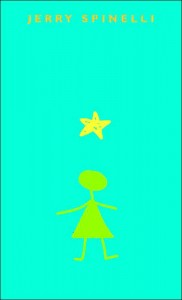 Right from the start, Stargirl is unlike anyone else Leo Borlock has ever met. Her unusual clothing, and ability to bring out the best in anyone, earns the self-named Stargirl a place of distinction among the otherwise-ordinary students of Mica High. She sings in public, remembers birthdays, delivers anonymous cards, has a pet rat, and roots for everyone, even the opposing team. She keeps files on people, so they’ll know what they were like when they were young, when they’re old enough to appreciate it. And for whatever reason, she’s fixed upon Leo as a kindred spirit. Initially, the school regards her with distrust and alienation, but over time, they grow to accept her whole-heartedly, even making her a cheerleader. All the while, Stargirl draws Leo further into her web of magic and beauty. Then, as these things will happen, Stargirl’s refusal to change to suit the masses leads to a horrible backlash, rendering her and Leo both outcasts. Leo, desperate for approval and acceptance by his peers, tries to get Stargirl to conform… but can an ordinary Susan overcome the disapproval of the others, and more importantly, will she want to?
Right from the start, Stargirl is unlike anyone else Leo Borlock has ever met. Her unusual clothing, and ability to bring out the best in anyone, earns the self-named Stargirl a place of distinction among the otherwise-ordinary students of Mica High. She sings in public, remembers birthdays, delivers anonymous cards, has a pet rat, and roots for everyone, even the opposing team. She keeps files on people, so they’ll know what they were like when they were young, when they’re old enough to appreciate it. And for whatever reason, she’s fixed upon Leo as a kindred spirit. Initially, the school regards her with distrust and alienation, but over time, they grow to accept her whole-heartedly, even making her a cheerleader. All the while, Stargirl draws Leo further into her web of magic and beauty. Then, as these things will happen, Stargirl’s refusal to change to suit the masses leads to a horrible backlash, rendering her and Leo both outcasts. Leo, desperate for approval and acceptance by his peers, tries to get Stargirl to conform… but can an ordinary Susan overcome the disapproval of the others, and more importantly, will she want to?

